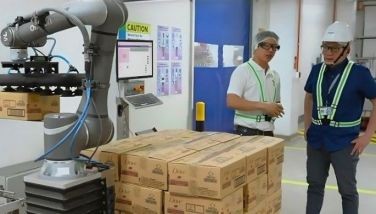Northern Metro Manila sinking fast - experts

System of Rice Intensification really works. One of this year’s six Ramon Magsaysay awards goes to a Cambodian promoter of SRI. Dr. Yang Saing Koma introduced SRI farming to 28 compatriots in 2000. Switching to SRI principles and practices, their harvest multiplied by 30 to 150 percent. Yet their use of seeds dropped 50-70 percent; same with their dependence on chemical fertilizers and pesticides. A decade later the government adopted SRI for 130,000 farmers, boosting Cambodia’s rice yield for domestic consumption and export.
Readers who wish to help rice farming kin, friends, and families of house help can read up on Dr. Koma’s success story on: www.cedac.org.kh/Report%20SRI.pdf. Or check out the Cornell University’s SRI homepage.
Then, enroll the farmers’ mobiles for free primers and text instructions by SRI-Pilipinas, hotlines 0939-1178999 or 0917-8117747, c/o Roberto “Ka Obet” Verzola.
SRI is not a rice variety but methods honed by a Jesuit agriculturist in Madagascar in the 1980s. In India last November five SRI users broke the world record of rice harvest of 380 cavans per hectare; the best of the five notched 448 cavans per hectare. The Philippine average is 80 cavans.
* * *
Is Metro Manila still safe to live in? Mayor Sherwin Gatchalian asks so in the wake of recent rains that left half of his Valenzuela City flooded for weeks.
It’s a question that all other mayors may well pose about their locales.
Gatchalian recounts that Tropical Storm Ondoy in 2009 dumped in half a day on the capital region one month’s usual rainfall. Homes and hospitals were swamped to the roof, factories and nearby farms ruined, hundreds of lives and billions of pesos in property lost.
Weathermen said back then that such phenomenon occurs only once in half-a-century. Yet three years later a tropical depression, exacerbated by habagat (southwest monsoon) unloaded in three days on the same area one month’s rains. Barangays spared by Ondoy before came under water this time.
Practically all cities and towns are now being pounded by stronger typhoons and downpours. Floods and mudslides in plains and hills have become so commonplace they no longer merit front pages. Other local officials must be lamenting like Gatchalian: “Residents will be at a loss if this keeps up.”
Combined derelictions have been pinpointed as causes. Choking of waterways by houses, factories, fish pens, and garbage; deforestation; wild quarrying, mining and urban sprawl. All these led to disasters in Baguio, Benguet, Ifugao; Cherry Hills in Antipolo City; Albay; Ormoc, San Francisco and Guinsaugon in Southern Leyte; Negros and Panay Islands; Surigao and Agusan; Cagayan de Oro and Iligan Cities.
Colossal infrastructures are being lined up, perhaps for preclusion as much as for commission. Yet, in most cases, all it needs is enforcement of old laws to prevent flood. Like, PD 296 against waterway encroachers, the Urban Development Housing Act, the Revised Forestry Code (PD 705), the Water Code (PD 1067), and the Barangay Rainwater Collector Act. (See Gotcha, 27 August 2012)
* * *
There’s one other thing. Northern Metro Manila is sinking fast. That’s why even light rains can cause deep flooding.
The drop in ground level is alarming: up to ten centimeters (four inches) a year, or one meter (one and one-third yards) per decade.
That’s in Camanava (Caloocan, Malabon, Navotas, Valenzuela cities). Also in nearby provinces: Bulacan, Pampanga, Bataan, and parts of Nueva Ecija, Tarlac and Zambales. Likely sinking too are the rest of the capital region, Luzon, and the country.
The cause: massive extraction of groundwater. This is being done via deep wells. They’re everywhere: malls, factories, commercial and government buildings, water-filling shops, churches, universities, residential subdivisions, golf courses, recreational parks, and farms.
The malady has long been studied by Professors Kelvin S. Rodolfo and Fernando P. Siringan. They are geological scientists of the University of Illinois-Chicago and the University of the Philippines, respectively. Rodolfo gained fame two decades back for his study of the Mt. Pinatubo eruption.
Their 19-page report came out 2006. Title: “Global sea-level rise is recognised, but flooding from anthropogenic land subsidence is ignored around northern Manila Bay, Philippines.”
Don’t let the title scare you; it’s easy reading for laymen. (www.clacc.net/documents/report/j.1467-9523.2006.00310.pdf or www.ncbi.nlm.nih.gov/pubmed/16512865)
Filipinos are aware of sea-level rise — and resultant creeping floods in coastal barrios — due to global warming. But this is only about one to three millimeters, the thickness of an eyeglass, per year.
Far worse yet largely ignored is subsidence, or land-level drop — thus worsening inland floods — due to unbridled groundwater removal. This accounts for centimeters and decimeters, ten to 100 times deeper, per year.
Adding to the problem is man-made earth compaction — construction of roads and buildings — that squeezes water out of the soil.
Flood-control dams are of no avail. They only give people a false sense of security. The recently finished Camanava Megadike has been adjudged a failure.
Rodolfo and Siringan suggest twin solutions: (1) regulate well pumping under the Water Code, and (2) replace groundwater loss, say, via dams and barangay rainwater catchments.
What’s happening in Camanava and environs is happening elsewhere. A decade ago industrialist Lucio Tan noticed seawater seepage into Ilocos region tobacco farms due to groundwater extraction. It prompted him to build them water impounders. Plantations in Mindanao and the Visayas are similarly being choked by salty ooze.
* * *
The Sigma Kappa Pi nationalist brotherhood commemorates on its 44th anniversary two historic events. The Revolution for independence began 116 years ago this month at Pugad Lawin. Martial law bludgeoned democracy 40 years ago next month, sparking a long fight for liberation. EKIT was founded in 1968 to defend freedom and democracy. The anniversary fete tomorrow, August 30, will be held at UP Diliman, QC. Wreath laying at the Bonifacio statue, Vinzons Hall, at 4 p.m.; fellowship at the Executive (President’s) House at 6.
* * *
Catch Sapol radio show, Saturdays, 8-10 a.m., DWIZ (882-AM).
* * *
E-mail: [email protected]
- Latest
- Trending




























